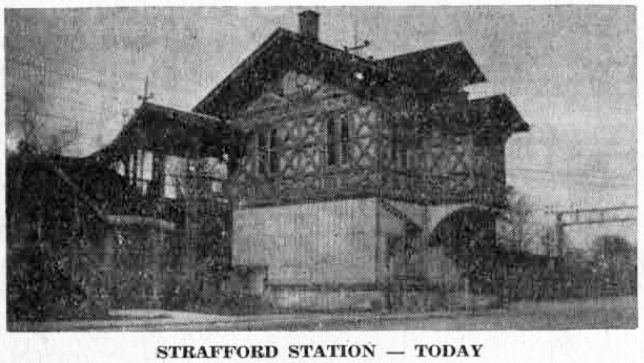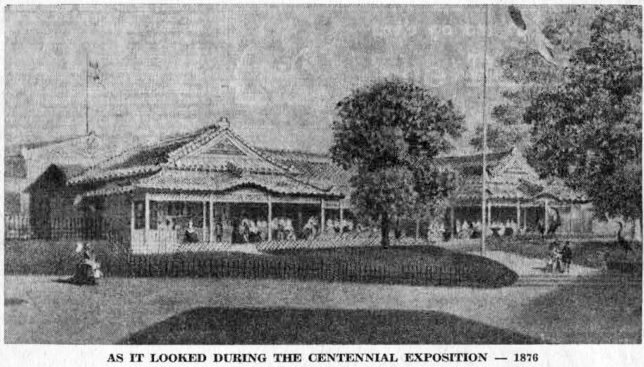The first time that your columnist heard the story of the origin of the present railroad station at Strafford, it was told her by Mrs. Martha Wentworth Suffren, whose memories perhaps antedate those of any other resident of Strafford.
Now in her 96th year, Mrs. Suffren was born in the lovely old house on Homestead road now owned by the Mr. and Mrs. Brooke Matlack, Jr. Originally built in 1856, by the White family of Philadelphia, it was bought a year later by Mrs. Suffren’s parents, Mr. and Mrs. John Langdon Wentworth, and called “Strafford.”
This Wentworth place, with its spacious home surrounded by its 130 acres, gave its name to Strafford station, formerly called Eagle because of the famous Spread Eagle Inn, which then stood in the settlement of Sitersville on the old Lancaster Turnpike.
Eagle station was originally located near a grade crossing, about one-third of a mile west of the site of the present Strafford station, at a point where the Old Lancaster road crossed what was then the two track line of the Pennsylvania Railroad. A four-track roadbed was completed in 1886, at which time all grade crossings were replaced by overpasses.
 Of this present Strafford station, “notes regarding certain stations on the Main Line of the Pennsylvania Railroad”, preserved in the Library of the Railroad, state that, “this small building is a relic of the Philadelphia Centennial Exposition held in 1876. It was built by Japanese workmen, and is put together with wooden pegs instead of iron nails. It was first used as the Japanese Building and later as the Illinois Building. The Pennsylvania Rail road bought it and used it first as the station at Wayne. Later, when the Drexel and Childs real estate development at Wayne called for a more imposing and commodious station, this small station was moved to its present location in 1887.”
Of this present Strafford station, “notes regarding certain stations on the Main Line of the Pennsylvania Railroad”, preserved in the Library of the Railroad, state that, “this small building is a relic of the Philadelphia Centennial Exposition held in 1876. It was built by Japanese workmen, and is put together with wooden pegs instead of iron nails. It was first used as the Japanese Building and later as the Illinois Building. The Pennsylvania Rail road bought it and used it first as the station at Wayne. Later, when the Drexel and Childs real estate development at Wayne called for a more imposing and commodious station, this small station was moved to its present location in 1887.”
Your columnist has since talked to several local residents. They recall that the building was carefully taken down piece by piece, loaded onto flat cars of the railroad, and moved a mile or so to the west and re-assembled at Strafford.
Even to the casual observer, it is evident that these parts made not only the ticket office in the south side of the tracks, but the shelter on the north side as well. The ornate architecture is the same and wooden pegs, instead of nails, have been used in putting both small buildings together.
 During the four years since your columnist first heard this interesting story from Mrs. Suffren, she has hoped that some day she might find a picture of this Japanese building at the Centennial to reproduce for the readers of this column. A short time ago, George W. Schultz brought forth from his collection of records of a bygone day the “Centennial Portfolio” from which the picture of the Japanese Bazaar illustrating this column has been taken. This portfolio was a souvenir of the International Exhibition at Philadelphia, published by Thomas Hunter, of 716 Filbert street, in 1876.
During the four years since your columnist first heard this interesting story from Mrs. Suffren, she has hoped that some day she might find a picture of this Japanese building at the Centennial to reproduce for the readers of this column. A short time ago, George W. Schultz brought forth from his collection of records of a bygone day the “Centennial Portfolio” from which the picture of the Japanese Bazaar illustrating this column has been taken. This portfolio was a souvenir of the International Exhibition at Philadelphia, published by Thomas Hunter, of 716 Filbert street, in 1876.
ln contrast to the picture of the Japanese Bazaar is the very recent one of Strafford station taken for this column by one of its most interested young readers, Robert C. Jones, of Orchard way and Louella avenue. Later installments of this series will describe both buildings more fully.
(To be Continued)
(The series on Radnor will be resumed at a later date. In the meantime Mrs. Patterson wishes to remind her readers of her desire for pictures of old Radnor houses and their histories.)
